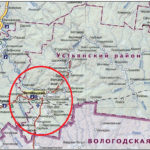Chmykhov А.А. , Leonova N.B. ALIEN SPECIES OF VASCULAR PLANTS IN PLANT COMMUNITIES OF THE MIDDLE TAIGA OF THE ARKHANGELSK REGION // Ecosystems: ecology and dynamics. No 3. 2023. P. 28-48. | Abstract | PDF | Reference
- The study area on the contemporary map of the Arkhangelsk Region
- Pine forest in the valley of the Kokshenga River (photo by A.A. Chmykhov)
- Lupinus pollyphyllus (photo by A.A. Chmykhov)
- Heracleum sosnowskyi (photo by A.A. Chmykhov)
- Overgrowing fallow land (photo by A.A. Chmykhov)
- Lupinus pollyphyllus in a clearing (photo by A.A. Chmykhov)
- Abandoned village (photo by M.B. Stevanovich)
- Matricaria discoidea DC on a field road (photo by A.A. Chmykhov)
In this article we discuss the distribution of alien species in the vegetation cover of the middle taiga of the Arkhangelsk Region. This is a relevant problem that has not been studied so far. We used the data of long-term biogeographic studies obtained from the Ustyanskaya Educational and Research Station located in the Arkhangelsk Region, M.V. Lomonosov Moscow State University, Faculty of Geography; as well as our own field materials for 2019-2022. We determined the composition of alien plant species in the study area and analyzed their taxonomic belonging, as well as their ecological and geographical characteristics. We used traditional methods of botanical-geographical field survey and desk processing of collected data, coupled with a list of scientific publications written on the role of alien species in plant communities. Moreover, we analyzed the ecological ranges of species based on D.N. Tsyganov’s ecological scales and mapped the mass occurrence of the most widespread alien species in the key sites of the study area. The results of this study revealed that alien species in the vegetation cover of the middle taiga of the Arkhangelsk Region currently account for about 9% of the floristic list, most of them being introduced into the region intentionally during agricultural activities. The taxonomic spectrum of such species is mostly represented by Asteraceae, Fabaceae and Brassicaceae families that are common in North America and Asia. In terms of coenotic aspects, these species are distributed mainly in floodplain and upland meadows communities, in fallow lands, secondary forests, anthropogenic coenoses of residential areas, along the roads. Most of these species grow in the middle taiga due to the presence of large river valleys, a well-developed agriculture and a railroad network.
Keywords: alien plant species, taxonomic composition, ecologic and coenotic composition, geographical elements, ecological scales, plant communities.
Funding. The work was carried out as part of the state task No. 121051100137-4 of the research topic “Spatial and temporal organization of ecosystems under conditions of environmental changes”.
DOI: 10.24412/2542-2006-2023-3-28-48
EDN: MUTZCE




















